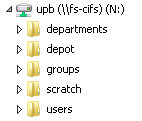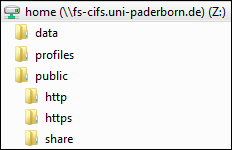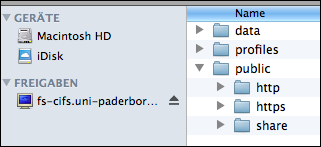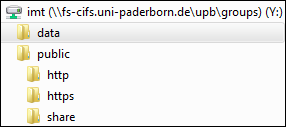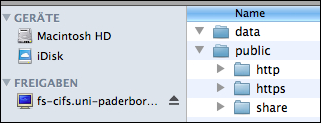The central file server of the IMT provides a global file system for the University of Paderborn, in which both central and decentralized areas are mapped.
All users and groups of the university have access to their own areas of this network storage space.
Directory structure[Bearbeiten | Quelltext bearbeiten]
The root directory is mounted on all Unix clients as /upb and is available on all Windows systems as drive N:.
The structure below is created as follows:
The respective subdirectories contain the home directories of the users, shared group directories, institute departments, archived research data and storage space for scratch data. On this page the individual areas and their respective structure are briefly described.
Please visit the corresponding other pages of the HelpWiki if you need instructions on Setup and Use of so-called network drives or detailed information on Rights management and Backup function of network storage.
User directory[Bearbeiten | Quelltext bearbeiten]
Each user is allocated a total of 5 GB of storage space on the file server (including the home or home directory). In such a user directory some system directories already exist by default:
- data - personal directory of each user. Here only the user has read and write access.
- profiles - institution-specific directories for logging on to computers in certain institutions or facilities.
- public/http(s) - directories for publishing web pages or other data on the WWW. Here, the user has read and write permissions, while all users can access it from the WWW for reading.
- public/share - directory for the exchange of data with others. Here the user himself has read and write permissions and every user of the university can read the content.
Group directory[Bearbeiten | Quelltext bearbeiten]
In addition to the user directories, there are so-called group directories that allow members to work together on documents. Here, too, files and web pages can be made publicly available. There is no uniform storage limit for group directories. This is assigned individually.
- data - private location for the group. Only group members have read and write permissions in this directory.
- public/http(s) - directories for publishing web pages or other data on the WWW. Here, the group has read and write permissions, while all users have read access from the WWW.
- public/share - allows the exchange of data with other users Here the group has read and write permissions and every user of the university can read the content.
Institute departments[Bearbeiten | Quelltext bearbeiten]
On the central file server, all departments of the institute are represented by one directory each, which can be accessed by the respective department with administration rights and in which it can organize its data. The size of this storage space is decided on a case-by-case basis.
Archived research data (depot)[Bearbeiten | Quelltext bearbeiten]
For long-term storage of research data, for example raw data from measurements, pictures, videos. This data will perspectively be stored on slower and less expensive storage media, but will remain in normal access and will be backed up.This location is therefore suitable for the long-term archiving of primary research data, which only needs to be accessed sporadically in read-only mode, but which must be kept for 10 years, for example, due to DFG guidelines.
Each group can request several sub-deposits in its group depot. An expiry date is set for each sub-depot, but it is not automatically deleted after expiry.
Scratch areas[Bearbeiten | Quelltext bearbeiten]
For the short-term storage of large amounts of data, for example for evaluations or calculations, a scratch area is provided on the file server to which users have access on request.
